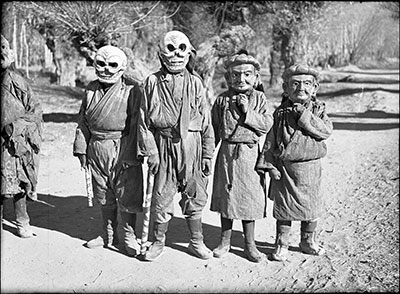
1998.131.258 (Film negative)


1998.131.258 (Film negative)

Frederick Spencer Chapman
Frederick Spencer Chapman
December 1st 1936
Lhasa > Dekyi Lingka
1998.131.258
85 x 113 mm
Negative film nitrate
Donated 1994
Faith Spencer Chapman
British Diplomatic Mission to Lhasa 1936-37
Frederick Spencer Chapman
C.15.13 [view film roll]
SC.T.2.258
In Negative - The number '13' has been scratched into the negative in the bottom right hand corner [MS 26/3/2005]
Technical Information - This image was taken with a quarter plate Zeiss Nixe film or film pack camera as the negative is quarter-plate sized. See Chapman Lhasa The Holy City [London: Chatto & Windus, 1938] for a description of the still and cine cameras that Chapman used as Mission photographer [MS 25/2/2005]
Manual Catalogues - Caption in Chapman's hand-written list of negatives made whilst on the Mission to Lhasa, 1936-7 [See PRM Manuscripts Collection]: 'Mummers - Group of 4' [MS 16/03/2006]
Other Information - Related Images: Images prefixed with 'C.15.' seem to have been taken over a relatively long period from November 26th to January 7th. This may have been because Chapman was running out of quarter plate film at this point because the only other images he took using this film type appear to have been of the interior of the Norbhu Lingka, the Potala and ceremonies at the Jokhang. However, on December 20th he comments that "something is wrong with the 1/4 plate camera" [1938: 294], which may have influenced his use of it. Images with prefix 'C.15' comprise a group of negatives containing images of threshing barley, Regent’s house, ferry near Dekyi Lingka and panoramic views of environs, mummers, Norbu Lingka, paper chase, tea at football match, Everest permit, Khampa people. This collection of images is headed with the title of ‘Rural Pursuits’ and it seems that Chapman may originally have intended to use this box of negatives whilst seeking out scenes such as threshing barley. However, this objective seems to have passed as the negatives were used, as a wider variety of images than this title suggests were taken. This may also reflect the limitations of access to such scenes in and around the mission compound in the Dekyi Lingka and the constraints upon the photographic agenda of the mission [MS 13/03/2006]
Other Information - Description: Chapman describes in the official Diary of the British Mission to Lhasa for the day of December 1st 1936 how this troupe of Lhasa mummers visited the Dekyi Lingka. He wrote in the entry for this date: "Some mummers came and danced for our entertainment. These are local performers as opposed to the more accomplished Khamba dancers and acrobats who tour the countryside professionally". See 1998.131.555/556/557 for images of the Khampa troupe. Chapman went on to describe the Lhasa mummers more fully in his published account of the Mission, Lhasa the Holy City [London: Chatto & Windus, 1938; reprint, London: Readers Union Ltd., 1940]. He wrote: "Another troupe that visited us was the Lhasa mummers. These were local artisans and farm labourers who occasionally spend an afternoon in this manner. There were eight men in all. One pair wore extremely skilfully made masks of bright green papier mache; another couple wore skeleton masks, while the third held a long striped stick and wore a mask with a vacant melancholy expression. The other three comprised the band - two with large drums, each supported by a handle, while the third played cymbals. // Various dances were performed in which the actors stepped solemnly round each other, made gestures with their arms and bowed, as they endeavoured to act traditional stories which seemed to be well known to the Tibetans. // Dancing, except when performed by the monks, is considered a very low caste occupation, and all the performers, both Khampas and mummers, seemed to be very poor" [1940, p.273] [MS 26/3/2005]
Other Information - Related Images: Other images of the Lhasa mummers can be seen in the series 1998.131.258-261 [MS 26/3/2005]
Other Information - Cultural Background: Although Chapman describes these masks as being made of paper, they are more likely to have been carved out of hardwood or made of cloth layered in a clay mould hardened with glue. They wouldn't usually be made of paper because paper was very rare and expensive. These appear to be made of carved wood [TS 31/1/2005]
For Citation use:
The Tibet Album.
"Lhasa mummers at Dekyi Lingka"
05 Dec. 2006. The Pitt Rivers Museum.
<http://tibet.prm.ox.ac.uk/photo_1998.131.258.html>.
For more information about photographic usage or to order prints, please visit the The Pitt Rivers Museum.
© The Pitt Rivers Museum